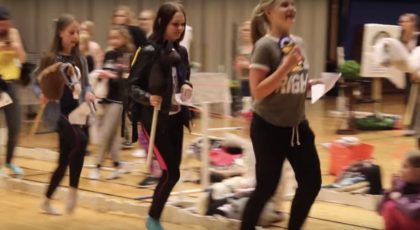Recently, a trainer that I admire on Twitter asked me, “How much would you ask to be paid to set jumps?” I thought this was an odd question, but I followed up with one of my own.
“Am I a barn kid, client, or just a random person at the barn?”
She replied that in this scenario, I was a barn kid. I sort of sat there, dumbfounded, as I looked down at my phone before replying. I would expect to be paid nothing. In fact, I would volunteer.
The exchange made me wonder, what has happened to the “barn rat-kids”? Are they still around?
Where does this generation of kids and teens that just show up, ride, and leave come from? Why have things changed? I can’t wrap my head around the premise that kids no longer want to take in every ounce of this sport that they can, especially since they all seem to want to be some sort of professional when they “grow up”.

(flickr.com/scottmontreal)
I was a barn rat. I was the kid that took the bus directly from school to the stable. I was the kid that set fences while my trainer was schooling, or sat up there with her asking questions as she taught lessons. I wanted to know, I wanted to learn, and I wanted to do anything I could to make it happen.
Eventually, in doing so, I earned rides, was given more responsibility, and landed a job. However, I never stopped going up to the arena to set fences or watch a group lesson. In fact, I still do that as a 24-year-old “shamateur” rider (my own term for those of us too poor to be amateurs, but not good enough to be pros). I still get to the barn early to watch or help out. I leave after the last lesson because I think that every rider, every horse, and every lesson will teach me something.
I feel like the era of barn rats is starting to run dry. Now kids are too busy to do more than ride, put their horses away, and leave. There is no picking up extra chores or asking their trainers, “What can I do for you?” They are expected to be paid in some way, whether it’s with an extra ride or with actual money to do simple things like set fences.
I’m not saying doing some work for an extra lesson or hack is a bad thing. In fact, I commend those that put in additional hours to be able to afford to ride, but I am talking about the people that expect to be remunerated for what I consider to be learning.
If you ask many young people participating in this sport what they want to do one day, their answers are often, “I want to be a pro on the A/AA circuit.” Are these the same kids that don’t want to work for it? Not all professionals have grooms and assistants. I think what most people don’t realize is that a majority of professionals barely break even at the end of the month. It can be incredibly unglamorous, which is why it takes a willingness to work and do the little things to actually make it in this industry.
Being a barn rat teaches you this exact thing. It shows you the real ins and outs of the life of a professional, and there are so many ways you can learn from your trainer outside of just taking lessons. Of course, if your trainer asks you to hack a horse or offers you some extra rides, take them! But also watch all the lessons you can, from the beginner kids and adult-ammies up to the advanced students. Ask questions about why and how your trainer does things.

©Alex Carlton
You see, money does play a role in this sport, but I think time and a willingness to work will always prevail. Your willingness to do those little, tedious, extra tasks and chores will bring you opportunities. Set the fences, watch the lessons, groom at shows, and open your eyes to the things you can learn in this sport without sitting in the saddle.
Be the barn rat! Your future students, clients, and business partners will thank you.
About the Author

(Courtesy of the author.)
Too poor to be an amateur, but not a good enough rider to be a pro, Mary Johnson is a self-proclaimed “shamateur” from Texas. She enjoys riding, Starbucks, and playing “horse show mom” to her barn mates. Her enemies include two-strides and Table II Section 2(c).




 November 7, 2016
November 7, 2016 



























